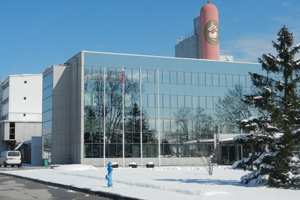Gavrilović ready to cover the European market

With Croatia estimated to join the European Union in mid-2013, it is interesting to have a look at what the country has to offer, pig-wise. Well known for its winter salami is the 320 yearold family company Gavrilovic. The company is in full speed of development.
There is plenty of history in the Gavrilović company. It was 1690 when the first ancestors of the Gavrilović family came from Bosnia to the area of current-day Petrinja, around 50 km south of the Croatian capital Zagreb. Daska Domljan, head of communications explains, “The first Gavrilović was a meat trader and the Gavrilović family is among the oldest families doing business in Europe.” Petrinja at that time was a strategic city, at the border of the Turkish and Austrian-Hungarian empires. The military forces in place at that time needed to be fed. The first factory was built in 1821 by Ivan Gavrilović. As it was not possible to find skilled workers in Croatia at that time, Gavrilović went to Udine in Italy and brought around 50 people to start the company. These Italian families stayed in the company for generations until 1967, bringing their knowledge and their know-how in producing winter salami, the flagship product of Gavrilović.
Two more years are important in the company’s history. The first is 1945, as in that year the company became nationalised; and 1991 when Gjuro Gavrilović, the son of the last owner, bought it back. As Petrinja was in the heart of a war zone during the Yugoslavian war (1991-1995), it was only in 1995 that production could be started up again with around 20 staff. During this war, Gjuro Gavrilović produced in a rented plant in Zagreb. Four years later in 1999 the production plant was rebuilt with the introduction of modern processing techniques. In 2004, the company rebuilt its pig breeding farm, today it has 500 sows (Yorkshire and Piétrain from Austria). Domljan says, “Today, Gavrilović is the oldest and most respected meat processing company in Croatia.” With a 42,900 m 2 modern processing plant in Petrinja, the company today has 720 employees, and a total output of 20,000 tonnes of meat per year, out of which 20% is exported. Before the last Yugoslavian war, the company used to have its own butcher school where people from all over the region came to be trained. Today this school does not exist any more – new employees are trained in the processing plant.
More than 150 products
Gavrilović has a ‘farm-to-fork’ organisation scheme, with production farms and a feed industry unit. Domljan explains, “The company has always owned its own production farms,” and points to a picture of the pig farm in a catalogue from 1906. The Gavrilović farm now produces 10,000 piglets per year, which are sold at 25 kg to farmers who finish them. These local finished pigs represent only 20% of the total raw material supply to provide fresh meat and processed products to Croatian butcheries. Zoran Stanojević, export manager, adds: “Most of our raw material is bought from certified European slaughterhouses, mainly from Germany, Denmark and the Netherlands.” The quality it bought depends on the recipes and products. Winter salami has been the company’s flagship product since 1883. The name ‘winter salami’ is a reminder of times when fridges did not exist and when production could only be made in winter. Domljan says, “We have a unique recipe which has not changed since the beginning, with premium ingredients and a natural maturation process.” For this, the Croatian Chamber of Commerce even awarded the company the ‘Croatian Creation’ label.
Included in the 150 plus products existing in the company’s range, they also count dry-cured salami, cured salami, pork liver pâtés, cooked sausages and Frankfurters, cooked hams and so on. The company launched new products last year, as for example the ‘Di Giusto’ new line of products to pay tribute to the Di Giusto Italian family who has worked for the Gavrilović company for years. The Di Giusto line uses an original Italian recipe, with local knowledge and tradition. Last year, the company also launched new flavours of premium pâtés, e.g. pâté with olives or pâté with prosciutto. Today, the plant is organized in four divisions: One for salami and cured meat, one for canned meat and pâtés, one for cooked sausages and one for salami.
More exports
For the moment, Bosnia and Slovenia are the leading export markets for Gavrilović, says Stanojević. In Slovenia, the company has 30% of the pâté market. Stanojević says: “Our goal is to have an agent or an importer in each European country.” He points to markets such as Germany, Austria and Scandinavia, having large numbers of ethnic Croatians. Last November, the company received a thumbs up to export again to the European Union. Stanojević says, “We have not been allowed to export to the EU due to sanitary restrictions as a result of Classical Swine Fever vaccination.” The opening of a brand new office building five years ago in Petrinja, has given the company a good image. And it will not stop there, as further investment projects are planned for the next two or three years. A major reconstruction of the existing plant is on a roll and so are plans to build another one. Stanojević says: “We
need more space and to improve our processes.” PP
Source: Pig Progress magazine 29.4 (2013)











